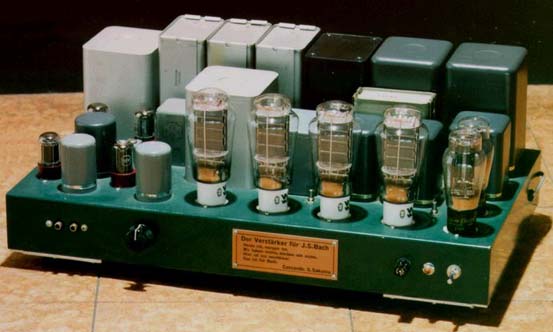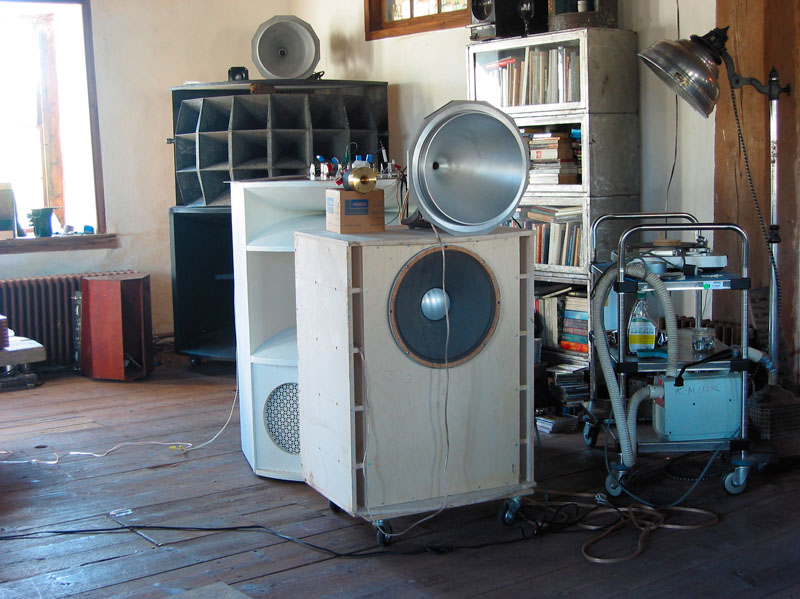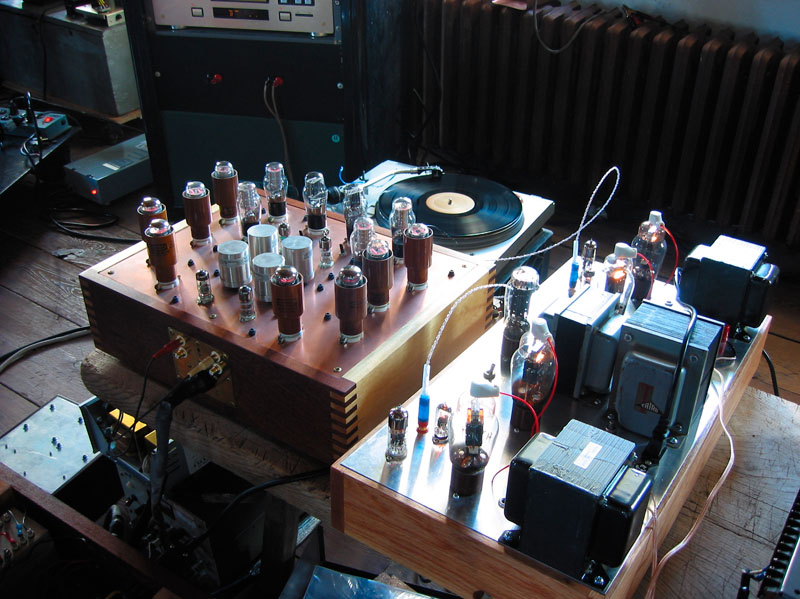Give Yourself the Gift of Music
July 15, 2007
OK, it’s a lovely summer day and I don’t feel like talking about economics for now. For that, buy a copy of my book from Amazon.com — it has a good year’s worth of material, and can be reread several times. I reread it myself from time to time.
Also, if anyone has information on the Bruening tax hike of 1930-1931 in Germany, specifically what tax rates where changed and by how much, that would be great. I’m also collecting info on the 1931 British tax hike.
But for now, I thought I’d try to write something about one of my goofy hobbies, for those who know nothing about it, so that they may become intrigued and also so that they can avoid various pitfalls on their way to some kind of lasting satisfaction in this arena. We are talking about — well, there isn’t even a proper name for it, so let’s call it fine audio. Basically, we mean machines for reproducing recorded music. It is dismally apparent to manufacturers of mass-market electronics that people put almost no value whatsoever on the quality of music reproduction. Indeed, even people who make music — musicians, studio engineers and the like — seem to put no value on the quality of reproduction, or, in their case, recording. The quality of most recordings, except for classical, is laughably degenerate. And, even if it wasn’t, it would be by the time it was reduced to an mp3 and sold by iTunes, which seems to be the preferred marketing channel these days.
Nevertheless, there is a lonely band of hobbyists who have bucked this trend, often to a ridiculous extreme. Mostly they are middle-aged professional males. Now, middle-aged professional males have lots of other uses for their time and effort, so it is on some level odd that they should be absorbed by what is clearly a second-rate hobby, compared to a first-rate hobby like mountaineering or actually making music (playing the guitar for example) instead of just reproducing it. Maybe it’s because MAPM don’t have the time for a first-rate hobby, and they just like listening to music. (Most first-rate hobbies take a serious commitment of time, energy and focus.) On the other hand, maybe there’s more to it than at first appears.
There are a lot of reasons for indulging in such silliness, and a lot of them are bad. The most basic reason is plain consumerism, in which Mr. Affluent Guy is looking for a new toy to go with his Mercedes and house in Aspen. The typical Mr. Affluent Guy has no knowledge whatsoever of what he is buying, and doesn’t care to except for a vague sense of the bragging rights that may come attached. A similar but slightly more sophisticated version is the Gadget Meister, who likes to play with machines. The modern world doesn’t provide many outlets for traditional Guy Stuff, as we are mostly computer-twiddlers these days. The Gadget Meister finds some outlet for this desire to wield tools and make things, whether it be customizing cars, refurbishing a vintage motorcycle, hotrodding PCs, doing some sort of construction/remodeling project, building a “home theater,” picking tools for a woodshop or what have you. The Gadget Meister, unlike Mr. Affluent Guy, has preposterously detailed knowledge of the engineering specifics of his object of interest. Indeed, the Gadget Meister is actually involved in working out all the ramifications and possibilities of a plethora of engineering questions. That is, actually, the hobby.
What about music? Oh yeah. If this is going to be a second-rate hobby, instead of a third-rate hobby, it has to be about music rather than machines. If the process of assembling a great music-making system has any point at all, it is because the assembler likes music. But everyone “likes music,” right? Sure they do — for fifteen seconds, or while they are running the vacuum cleaner. A real music lover treats recorded music like a live concert. They sit and listen, for the whole CD, without talking or doing other stuff — unless the music stinks, in which case they search for some new music to satisfy their interest. Most everyone is capable of sitting and watching a movie (or DVD), and, over time, understands the difference between a “good” movie and one that is just more Hollywood junk. A music lover does the same with recorded music. Both get an aesthetic and emotional charge out of the process. That’s what art is about.
Music lovers are relatively rare. Of those, there are many who are happy with their iPods, or at least have little inkling that anything else exists. In all seriousness, very few people have even heard a serious music reproduction system, so how would they know if they like it or not? About the best most people get is in movie theaters. Most amplified live music — everything except classical — is quite dismal, with the possible exception of guitarists who are using their own amps without additional amplification. Even unamplified classical music can be disappointing, which I attribute mostly to overly-large performance halls. Despite the notion that the purpose of a music reproduction system is to “recreate a live event,” in truth most live events are rather disappointing from a sound quality standpoint, and often from a performance standpoint as well. (Admit it — the “live” album usually doesn’t sound as good as the studio version, right?) There is something to be said about the spontaneity of a live performance, however.
Music lovers are often happy to just purchase something that seems pretty decent, and leave it at that. Whatever it is, it will be much better than an iPod and those silly little earbuds. Others become fascinated by the increase in emotional involvement that can be provided by a good reproduction system, and continue down that road for a while. In any case, we have by now defined what it actually is that we are trying to do, at least if this hobby is to attain second-ratehood. It’s about enjoying music with increased aesthetic and emotional involvement.
Unfortunately, we can’t just go to the store and buy a bottle of “100% pure organic aesthetic and emotional involvement.” The trick is to get from your iPod to this more-heavenly state using an arrangement of electronic parts, as opposed to a different arrangement of electronic parts. Hmmmm. This process supports a rather extraordinary sub-industry of equipment-makers, characterized by an incredible profusion of hundreds if not thousands of mostly tiny-scale manufacturers and very high prices, compared to mass-market goods. The high prices reflect high R&D costs, higher parts costs, and few economies of scale. Sometimes a company will only make fifty or a hundred copies of a product. The business is notoriously unprofitable. It resembles, in large degree, the fashion industry. Mass-produced clothing, these days, is amazingly cheap, as are mass-produced electronics. If you want to go beyond the Gap and Talbot’s level of sophistication, however, prices rise enormously. The higher prices support a profusion of choice. Really, fine audio is a cheap hobby compared to high fashion as represented by Vogue, Elle or other such magazines. And compared to vacation houses? Not on the same planet.
Nevertheless, it is quite common for the newcomer to spend several years (expensive years!) bewildered by the profusion of choice, once one gets beyond the mass-market stage in which everything is essentially the same. Mr. Affluent Guy says “this is the best — this is what you want to do,” and Mr. Gadget Meister says “no, this is the best — this is what you want to do.” Actually, there is a constant debate about such things, further confused by the marketing efforts of companies themselves, who are busy selling to Mr. Affluent Guy and Mr. Gadget Meister, as these two groups constitute the source of most revenue. The music lovers, after some time, generally leave this arena.
Another funny thing is, higher prices do not necessarily correspond with better results. Often, the exact opposite is the case. This is doubly bewildering to most shoppers. You can’t buy your way to the top (take that Mr. Affluent Guy). A good music reproduction system is about synergy between elements, and is also a reflection of the aesthetic sophistication of the creator. It begins to resemble a musical instrument itself, like a piano, which is also a complex machine. Over the past fifty years, certain “modalities” have emerged that have produced good results time and time again. If any newcomers are wondering where this path ends, it tends to end somewhere around here:
1) Vacuum tubes. Yes, vacuum tubes. Expensive and somewhat difficult to work with, although they are much more reliable than is often assumed. Tubes plain sound good. Solid state (transistor) based electronics might sound good — indeed, they are vastly better these days in response to the competition provided by a resurgence of interest in vacuum tubes — but it always seems as though designers are fighting the difficulties inherent in the medium. There are terrible-sounding tube electronics. There are wonderful-sounding solid state electronics. Both are exceptions to the rule.

An amplifier by Japanese builder Susumu Sakuma, based on the 300B tube first made in the 1930s.
This is a one-of-a-kind handmade original. Nice retro-industrial style!
2) Vintage-type speakers. You can still buy crazy old vintage stuff for not much money, although the prices are rising from the 1980s when you could basically get the stuff for free. The Altec theater horn systems of the 1940s and 1950s — while not the ultimate — are nevertheless in the same neighborhood as the ultimate, and can still be obtained for peanuts. Remember that great old movie theater sound of the 1960s? That was probably an Altec system driven by vacuum tubes.

An Altec A5 system, from the 1940s or 1950s. I recently bought one for $500.

Three speaker systems, a little bit retro and a little bit cutting-edge.
As for a music source, it is worth considering vinyl records, as there are still many of them around that can be bought cheap, and they sound great. Not too much new material released on vinyl, though. For new music, buy CDs rather than downloading mp3s from iTunes. Classical music lovers have a bonanza of material on vinyl.
![]()
A Garrard turntable from the 1960s, rebuilt in a new cabinet.

A selection of handbuilt one-off designs.
Well, maybe this will inspire someone to take their music listening to the next level of enjoyment. Good luck! And don’t spend too much money. Remember, it’s about emotional and aesthetic involvement. If you don’t have that, you don’t have much.
More reading about great music reproduction systems:

